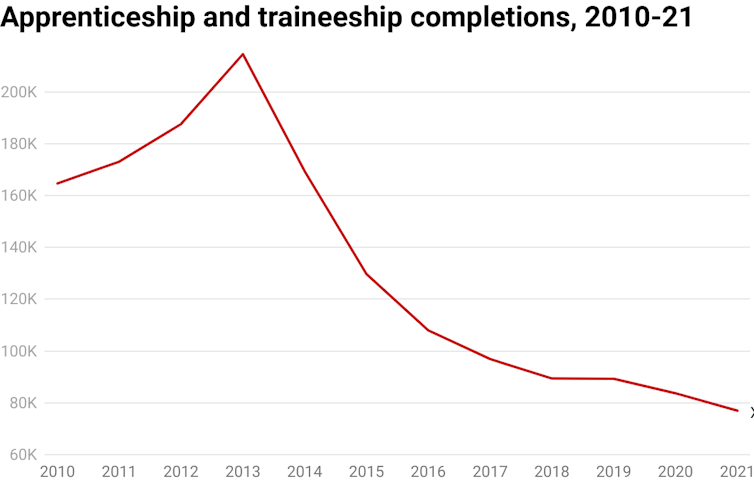Who'll teach all the students promised extra TAFE places? 4 steps to end staff shortages
- Written by Darryl Dymock, Adjunct Senior Research Fellow in Education, Griffith University

Under Labor’s proposed Future Made in Australia Skills Plan, Australians studying in an industry with a skills shortage will be supported through the provision of free TAFE places. This will include 45,000 new places. If Labor does that without expanding the present depleted teaching workforce, we’re likely to see more current teachers bailing out and corners cut in teaching practices.
Our 2021 research for the National Centre for Vocational Education Research (NCVER) found the shortages of VET teachers and trainers extend to virtually every industry. If these shortages are not overcome, the result will be an inadequately trained vocational workforce. This in turn will have an impact on the country’s skill levels and productivity.
Not that the present federal government has much to be proud of in this regard. Although Vocational Education and Training (VET) significantly underpins the nation’s workforce development, it has limped along under recent national governments.
TAFE, the public provider, has remained a poor relation. Workforce shortages have continued, made worse by retirements from the ageing VET workforce and by the need to expand training to cater for new and emerging industries.
For our research we talked with key members of almost 30 registered training organisations (RTOs) across Australia about the shortage of trainers. We also surveyed over 300 practising teachers and trainers (VET practitioners) about their experiences of moving into VET.
The challenge in overcoming the shortage of VET practitioners is to encourage experienced workers from trades and the professions to move into VET.
What are the key issues?
The difference in salaries between industry and VET is a significant issue. It’s too simplistic an explanation for the lack of applicants, however.
For example, one disincentive is the nature of employment in the sector. Just over half of VET practitioners are employed in ongoing full-time roles. As one said:
“People at the top of their industry don’t leave for a temporary contract.”
Private training organisations reported they sometimes provide permanent employment for trainers simply to keep them “on the books”. One RTO principal told us:
“I can’t afford to put them off because we’ll never get them back.”
A further stumbling block is the inflexibility of the basic educational qualification as a point of entry. Trainers generally need to complete a Certificate IV in Training and Assessment (Cert IV TAE) before they can teach. There is only minimum provision for supervised practice without it.
Training organisations reported prospective trainers are reluctant to acquire the full qualification before they’re allowed to teach. Tradespeople with significant practical experience but no formal education since their apprenticeship were also anxious about “returning to study”.
Paradoxically, there was pushback from university-educated professionals in senior positions against the need for a vocational qualification.
The value of the certificate itself as a training qualification has been an ongoing contentious issue. One ex-tradie wrote:
“They want teachers to have ten years of industry experience […] but expect a six-day course to be enough to be a good teacher.”
It’s understood changes to the qualification are in the wind. Let’s hope these include ones that will make entry to VET teaching more flexible.
Training organisations and trainers alike argued for better recognition of prior learning among those who already have a training or mentoring role.
Even after they make the transition, new practitioners sometimes leave VET because their expectations don’t meet the reality. This is especially true if their employer doesn’t provide appropriate orientation and support. One trainer said:
“Day one I was given a USB with PowerPoint presentations on it and told to go into the classroom and deliver it.”
Authors: Darryl Dymock, Adjunct Senior Research Fellow in Education, Griffith University



